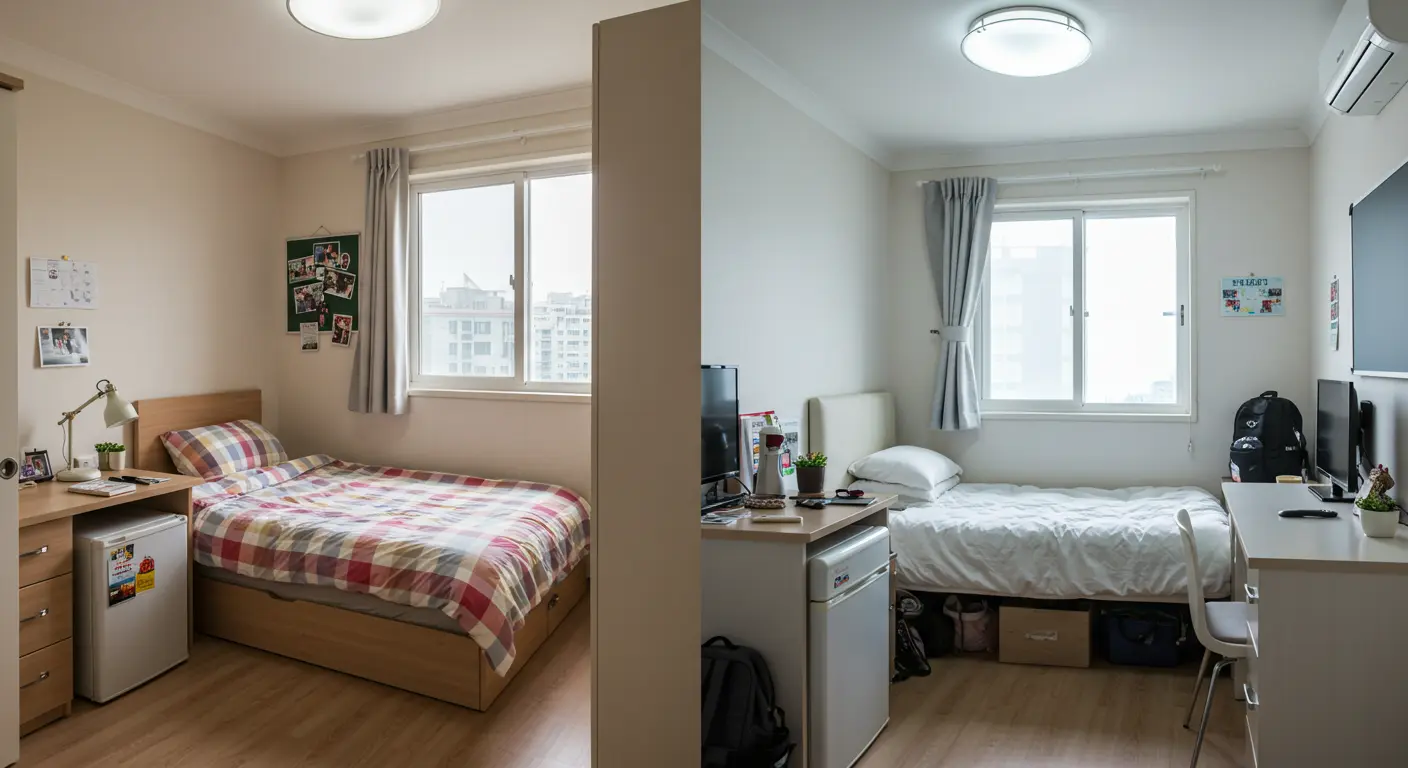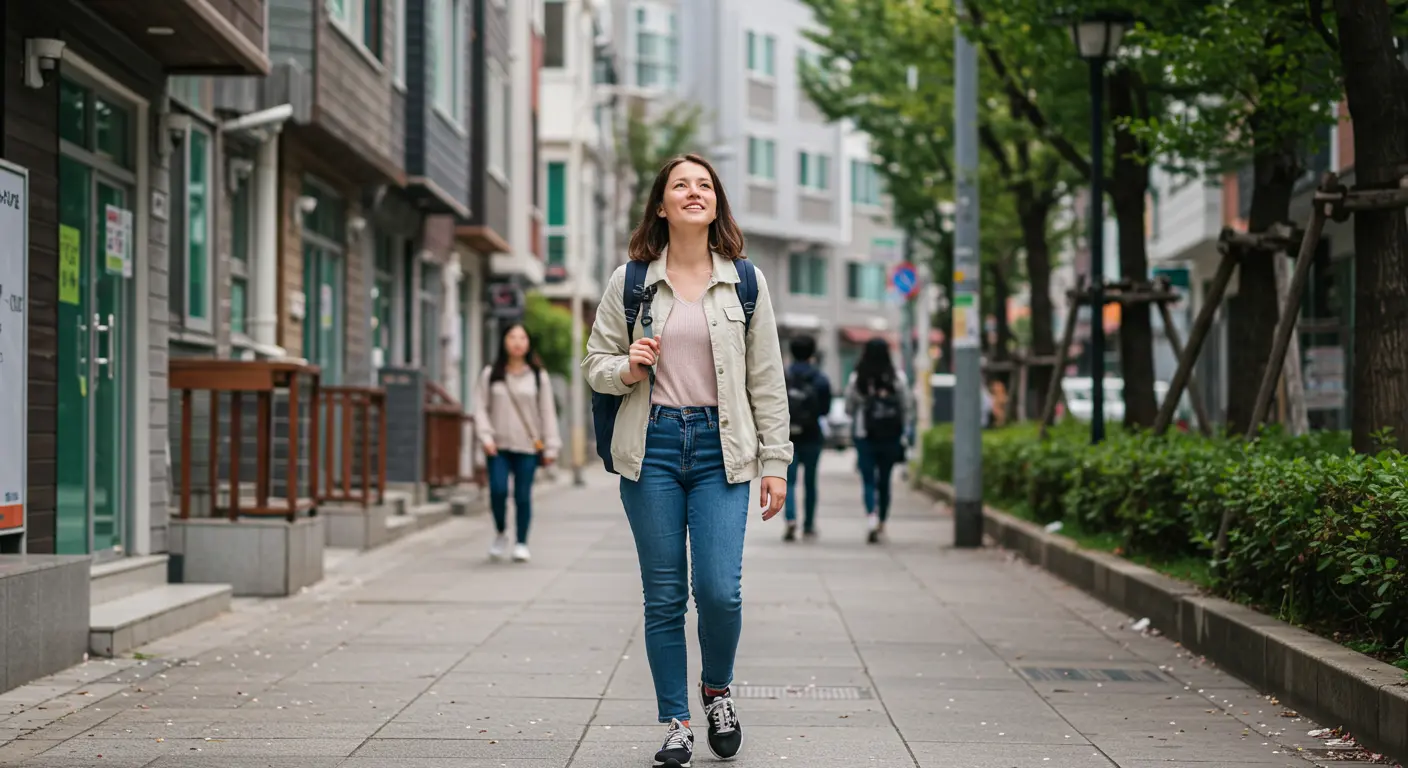Bottom line: Hasukjib is a traditional Korean boarding house, a unique housing option that offers international students an affordable and immersive experience in Korean culture. For KRW 400-500,000 per month, you get meals and access to shared facilities.

1. What is a boarding house?
Hasukjib is a traditional form of dormitory in South Korea, and is an affordable housing option used primarily by college students. “Hasukjib” means “sleeping outside the home” and is usually run by middle-aged women (ajumma). Wikipediaare still easily found around Seoul’s university districts in 2025, and offer foreign students a unique opportunity to immerse themselves in Korean culture.
1. Private bedrooms available (6.6 sq. ft. to 13.2 sq. ft.)
2. Includes 2 meals per day (breakfast and dinner)
3. Access to public restrooms and laundry rooms
4. Fully furnished (bed, desk, chair, mini-fridge)
2. Boarding Houses vs. Boarding Schools: Key Differences
Many international students confuse boarding houses with boarding schools, but there are clear differences between the two types of housing. The biggest differences are the availability of meals and the community culture. A boarding house is a great way to experience Korea’s “jung” culture, while a gosokwon is more individualistic.

1. Meals: Breakfast and dinner at a hagwon vs. only basic ingredients (rice, kimchi) at a goswon
2. Cost: Boarding house 40-55 KRW vs Gosokwon 20-40 KRW
3. Room size: Boarding houses are typically larger (9.9 sq. ft. vs. 6.6 sq. ft. on average)
4. Social environment: Boarding houses are community-oriented vs. boarding schools are individual-oriented
5. Contract terms: Both require a deposit of 100,000 to 200,000 won, and rent is paid in advance.
3. Boarding house costs and realities in 2025
As of 2025, the boarding house market is recovering from COVID-19. Korea HeraldWith the average monthly cost of a studio room near major universities in Seoul exceeding 600,000 won, boarding houses are making a comeback, especially among Generation MZ students, who are increasingly choosing them for practical reasons due to the high cost of housing.
1. Monthly cost: 400,000 (basic) to 550,000 (better facilities), including meals
2. Deposit: 100,000 to 200,000 won (very cheap compared to a deposit of 30,000 won for a studio)
3. Differences by location: Sinchon-Hongdae area is the most expensive, while the outskirts are relatively cheaper
4. Additional costs: 2-5k extra per month for summer/winter heating and cooling
5. Reservation status: Popular regions close early before the start of the semester
4. How to find a boarding house
Finding a boarding house is more effective in person than online. This is because most boarding house operators are not internet savvy and have limited online information. GoshipagesThere are also specialized sites, such as Airbnb, but finding a successful boarding house requires time and patience.

1. In person: Wander down a college town alley and check for “boarding house” signs
2. Online sites: Goshipages.com, Gosi1.net Utilization
3. Best time: 1-2 weeks before the start of the semester, 10am-6pm
4. Preparation: Basic Korean conversation skills, passport, cash
5. Checklist: Check room size, bathroom sharing, meal times, and rules
5. Practical advice for foreigners
Living successfully in a boarding house as a foreign student requires understanding and adapting to Korean culture, especially getting used to the communal living rules and eating culture in advance. Even if there is a language barrier, you can greatly improve your Korean language skills by communicating with your aunt.
1. Language preparation: Basic everyday Korean (greetings, meal-related expressions) required
2. Cultural adaptation: Adhere to meal times and quiet hours (after 10 p.m.)
3. Build relationships: Maintain a good relationship with your aunt, greet other residents
4. Practical tip: If you can’t eat Korean food, you’re not fit; ask permission before inviting friends over
5. Emergency contacts: Prepare contacts for your university’s international office and Korean friends
💡 â More information on adjusting to life:
1. A Foreigner’s Complete Guide to Public Transportation in South Korea – Essential for traveling from boarding house to university
2. The Complete Guide to a Day in the Life of a Foreigner in Seoul 2025 – 5 Essential Experiences for Adjusting to Life in Korea
6. Frequently asked questions (FAQ)
Q1. Isn’t it hard for foreigners to find a place to stay?
A1. Some dormitories may not welcome foreigners, but if you can communicate in basic Korean, you shouldn’t have any problems. Areas with many international students, such as Sinchon and Hongdae, are very foreigner-friendly.
Q2. Do I need to write a contract?
A2. Most agreements are verbal and involve paying the first month’s rent in advance and getting a receipt. If necessary, you may be asked to write a simple confirmation letter.
Q3. What if a meal doesn’t fit in my mouth?
A3. If you can’t eat Korean food, a boarding house is not for you. SNU International Student Guidesays that Korean food (kimchi, miso stew, etc.) is served daily, and it’s hard to cater to personal preferences.
Q4. Is it possible for short-term (3-6 months)?
A4. It is possible, but the aunts prefer long-term residents. For short-term stays, you need to clarify the duration in advance and give a month’s notice of your intention to leave.
Q5. What’s the difference between a boarding house and a share house?
A5. Boarding houses are managed by a hostess and meals are provided, while share houses are self-managed by students. Recently, many boarding houses are converting to share houses.
7. related reading
Official university information
1. Official Seoul National University Dormitory Guide – Seoul National University Housing
2. SNU International Student Housing Guide – International Summer Program
3. SNU Office of International Affairs Off-campus Housing Information – Official International Affairs
4. Goshipages – A specialized search site for gosokwon and boarding houses
A guide to settling into life in Korea
1. Decorating a Tiny Apartment 2025: Neutro Decor & Life Hacks – Preparing for life in a studio after a boarding house
2. A Guide to the Korean Recommerce Market – How to save on student supplies
